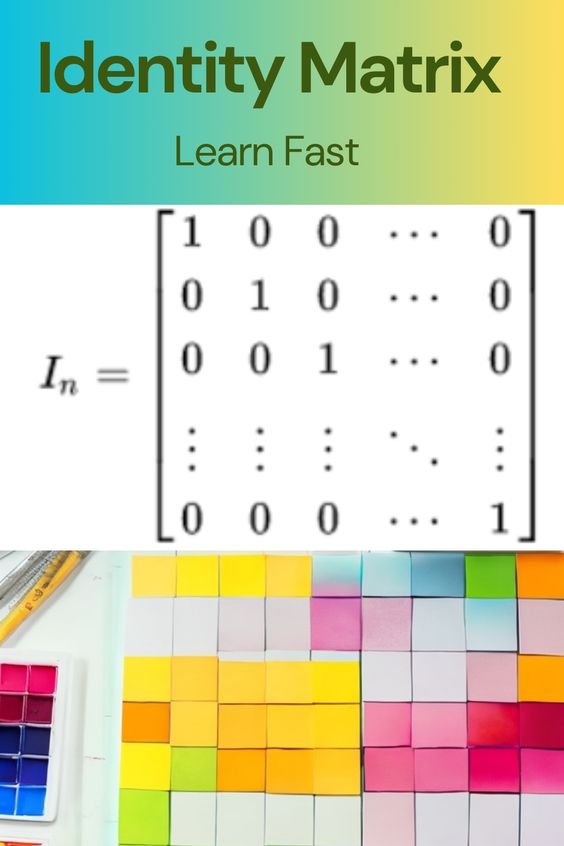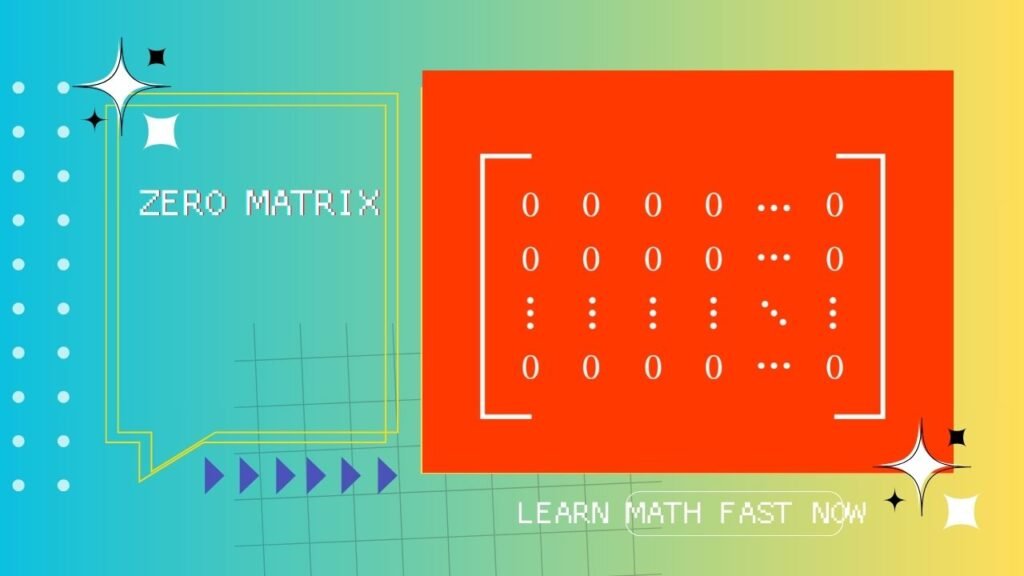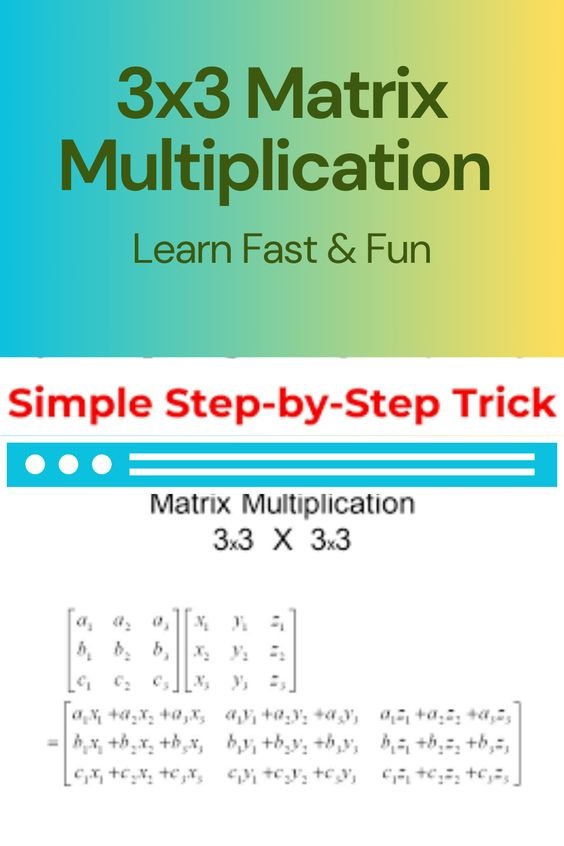Identity Matrix – Definitioin,examples,worksheets & Cool math art project

We discuss here about identity matrix.
What is an Identity Matrix?
An identity matrix is a square matrix with ones on the main diagonal and zeros everywhere else. The main diagonal is the diagonal that runs from the top left corner of the matrix to the bottom right corner.
Here is an example of a 3×3 identity matrix:
[1, 0, 0] [0, 1, 0] [0, 0, 1]
The identity matrix is often denoted by the letter I.
Identity matrices are important in linear algebra, which is a branch of mathematics that deals with matrices. They are used to perform many different operations on matrices, such as multiplying matrices, adding matrices, and finding the inverse of a matrix.
Determinant of an Identity Matrix
The determinant of a matrix is a number that tells us something about the matrix. It can be used to find out if a matrix is invertible, for example. An invertible matrix is a matrix that has a multiplicative inverse. This means that there is another matrix that, when multiplied by the original matrix, gives us the identity matrix.
The determinant of an identity matrix is always 1. This is because the product of the main diagonal entries is always 1, and the product of the zero entries is 0.
Let’s take a look at an example. Here is a 2×2 identity matrix:
[1 0]
[0 1]
The determinant of this matrix is:
det(I) = (1)(1) - (0)(0) = 1
The product of the main diagonal entries is 1, and the product of the zero entries is 0. Therefore, the determinant is 1.
No matter the size of the identity matrix, be it 2×2, 3×3, or any “n” by “n” identity matrix, its determinant consistently evaluates to the value of 1. This might seem almost magical, but there’s an elegant explanation behind it. Consider the main diagonal entries of the identity matrix, which are all ones. When we multiply these ones together, the product remains 1. Simultaneously, the zero entries outside the main diagonal have no impact on the overall product, as multiplying anything by zero results in zero.
This elegant interaction between the main diagonal entries being exclusively ones and the other entries being zeros results in the determinant of an identity matrix always being 1, regardless of its size. This is a remarkable property that sets the identity matrix apart as a cornerstone of matrix operations.
Invertibility of an Identity Matrix
A matrix is invertible if there exists another matrix, called its inverse, such that when the two matrices are multiplied together, the resulting matrix is the identity matrix. The identity matrix is a special matrix that has all ones on the main diagonal and zeros everywhere else.
The identity matrix is always invertible. This is because any matrix that has a determinant of 1 is invertible. The determinant of a matrix is a number that tells us how much the matrix stretches or shrinks space. The determinant of the identity matrix is always 1, so the identity matrix is always invertible.
To see why this is true, let’s consider the following identity matrix:
I = [1 0]
[0 1]
The inverse of the identity matrix is also the identity matrix. This is because when we multiply the identity matrix by itself, we get the identity matrix:
I * I = [1 0] * [1 0] = [1 0]
[0 1] [0 1]
Therefore, the identity matrix is always invertible.
How to Find an Identity Matrix
To find an identity matrix, you just need to fill in the main diagonal with ones and the rest of the matrix with zeros.
For example, to find a 5×5 identity matrix, you would do the following:
- Fill in the main diagonal with ones.
- Fill in the rest of the matrix with zeros.
Here is the resulting 5×5 identity matrix:
[1, 0, 0, 0, 0]
[0, 1, 0, 0, 0]
[0, 0, 1, 0, 0]
[0, 0, 0, 1, 0]
[0, 0, 0, 0, 1]Identity Matrices examples
Matrix Addition with Identity Matrix
Let’s consider a matrix A and the 2×2 identity matrix I:
Matrix A:
| 3 5 |
| 1 2 |
Identity Matrix I:
| 1 0 |
| 0 1 |
When we add matrix A to the identity matrix I, we get back matrix A itself:
A + I =
| 3 5 | + | 1 0 | = | 3+1 5+0 |
| 1 2 | | 0 1 | | 1+0 2+1 |
= =
| 4 5 |
| 1 3 |
Matrix multiplication with the identity matrix
Matrix B:
| 4 6 |
| 3 5 |
Identity Matrix I:
| 1 0 |
| 0 1 |
When we multiply matrix B by the identity matrix I, we get back matrix B itself:
B * I =
| 4 6 | * | 1 0 | = | 4*1+6*0 4*0+6*1 |
| 3 5 | | 0 1 | | 3*1+5*0 3*0+5*1 |
= =
| 4 6 |
| 3 5 |
Inverse Matrix and Identity Matrix
If matrix A is multiplied by its inverse A⁻¹, the result is the identity matrix:
Matrix A:
| 2 1 |
| 5 3 |
Inverse of A:
| 3 -1 |
| -5 2 |
A * A⁻¹ =
| 2 1 | * | 3 -1 | = | 2*3+1*-5 2*-1+1*2 |
| 5 3 | | -5 2 | | 5*3+3*-5 5*-1+3*2 |
= =
| 1 0 |
| 0 1 |
Identity Matrices in AI
Have you ever wondered how AI works? What makes it possible for computers to learn and make decisions? One of the key concepts behind AI is the identity matrix.
An identity matrix is a square matrix that has ones on the main diagonal and zeros everywhere else. For example, a 3×3 identity matrix would look like this:
[1, 0, 0]
[0, 1, 0]
[0, 0, 1]
Identity matrices are used in AI for a variety of purposes. One common use is to represent the identity function. The identity function is a function that takes any input and returns the same input. For example, the identity function for numbers would be the function f(x) = x. This function takes any number as an input and returns the same number as an output.
In AI, identity matrices are used to represent the identity function because they do not change the values of the vectors that they are multiplied by. For example, if you multiply a vector by an identity matrix, the output vector will be the same as the input vector.
This property of identity matrices makes them very useful for representing the identity function in AI. For example, if you are training a neural network to recognize images, you can use an identity matrix to represent the identity function in the output layer of the neural network. This will ensure that the neural network does not change the values of the output vector, but instead simply returns the input vector.
Another common use of identity matrices in AI is to represent the addition of vectors. The addition of vectors is a function that takes two vectors as inputs and returns a vector that is the sum of the two input vectors. For example, if you have two vectors, v1 and v2, the addition of vectors function would return a vector v3 such that v3 = v1 + v2.
In AI, identity matrices are used to represent the addition of vectors because they simply add the corresponding elements of the two vectors together. For example, if you multiply a vector by an identity matrix, the output vector will be the same as the input vector, but with all of the elements doubled. This is because the identity matrix simply adds 1 to each element of the input vector.
This property of identity matrices makes them very useful for representing the addition of vectors in AI. For example, if you are training a neural network to add two numbers, you can use an identity matrix to represent the addition of vectors in the hidden layer of the neural network. This will ensure that the neural network does not change the values of the output vector, but instead simply adds the two input vectors together.
Identity matrices are a powerful tool that can be used in a variety of ways in AI. By understanding how identity matrices work, you can better understand how AI works and how it can be used to solve problems.
In addition to the uses mentioned above, identity matrices can also be used for:
- Calculating the determinant of a matrix
- Solving systems of linear equations
- Simplifying expressions involving matrices
- Representing rotations and reflections in 3D space
Identity matrices are a fundamental concept in linear algebra, and they are essential for understanding and using AI. If you are interested in learning more about AI, I encourage you to learn more about identity matrices.
Symmetric Identity Art – Cool math art project of identity matrices

We’ll explore the beauty of identity matrices through symmetry and creativity.
Materials Needed:
- Canvas or drawing paper
- Acrylic paints or watercolors
- Brushes
- Ruler
- Pencil
- Optional: Different sizes of circular objects (e.g., lids, cups) for tracing
Instructions:
- Creating the Background:
- Start by selecting a canvas or a sheet of drawing paper.
- Use acrylic paints or watercolors to create a colorful and abstract background. You can blend different colors, create gradients, or experiment with various painting techniques.
- Planning the Symmetry:
- Decide on the number of identity matrices you want to incorporate into your art piece.
- Using a pencil and ruler, lightly draw vertical lines to divide the canvas into sections where the identity matrices will be placed. Ensure that the sections are symmetrically distributed.
- Drawing the Identity Matrices:
- In each section, draw a circle using a circular object or freehand to represent the identity matrix.
- Inside the circle, draw a diagonal line from one corner to the opposite corner. This line symbolizes the main diagonal of the identity matrix.
- Painting the Identity Matrices:
- Paint the inside of each circle with a solid color that contrasts with the background. You can choose a single color for all circles or use a different color for each.
- Adding Details:
- To enhance the visual appeal, consider adding subtle patterns, textures, or smaller shapes within each circle. These details can be painted or drawn using fine-tip brushes or markers.
- Finishing Touches:
- Once you’re satisfied with the identity matrices and their surroundings, let the artwork dry completely.
- You can add a title or any additional elements that complement the theme of symmetry and identity matrices.
The final art piece will be a visually captivating representation of identity matrices. The combination of bold, colorful circles and the diagonal lines within them will evoke a sense of balance, symmetry and mathematical beauty.
This project not only allows for creative expression but also reinforces the concept of identity matrices in a unique and engaging way. It’s a wonderful opportunity to bridge the gap between math and art while creating a visually stunning piece.
Introduction to Identity Matrices
Matrix A:
| 2 0 |
| 0 2 |
Matrix B:
| 5 3 |
| 1 5 |
Matrix C:
| 1 0 |
| 0 1 |
Questions:
- Which matrix is an identity matrix? (A, B, C)
- Calculate the product of Matrix A and Matrix C.
- Calculate the product of Matrix B and Matrix C.
- What is the main property of an identity matrix?
- Can an identity matrix have any value other than 1 along the main diagonal? (Yes/No)
Answers:
- Matrix C
- Matrix A
- Matrix B
- The main property of an identity matrix is that it leaves other matrices unchanged when multiplied with them.
- No
Identity Matrix Puzzles
Matrix X:
| 7 0 |
| 0 7 |
Matrix Y:
| 0 4 |
| 4 0 |
Matrix Z:
| 1 1 |
| 1 1 |
Questions:
- Can Matrix X be an identity matrix? (Yes/No)
- Calculate the product of Matrix Y and Matrix Z.
- Calculate the product of Matrix Z and Matrix Z.
- If Matrix X is an identity matrix, what value should it have along the main diagonal?
- Determine which matrices are symmetric. (X, Y, Z)
- Can a matrix with all elements equal to 1 be an identity matrix? (Yes/No)
Answers:
- No
- Matrix X
- Matrix X
- 7
- Y, Z
- No
Identity Matrix Operations
Matrix I:
| 1 0 |
| 0 1 |
Matrix A:
| 3 5 |
| 2 4 |
Matrix B:
| 6 8 |
| 7 9 |
Questions:
- Identify the identity matrix from the given matrices.
- Calculate the product of Matrix I and Matrix A.
- Calculate the product of Matrix A and Matrix I.
- Find the sum of Matrix I and Matrix B.
- Is the product of Matrix A and Matrix B an identity matrix?
Answers:
- Matrix I
- Matrix A
- Matrix A
- Not possible, as the matrices have different dimensions.
- No
Identity Matrix Properties
Matrix X:
| 5 0 |
| 0 5 |
Matrix Y:
| 1 2 |
| 3 4 |
Matrix Z:
| 0 0 |
| 0 0 |
Questions:
- Determine whether Matrix X is an identity matrix.
- Calculate the product of Matrix X and Matrix Y.
- Calculate the product of Matrix Y and Matrix X.
- Determine whether Matrix Z is an identity matrix.
- Calculate the product of Matrix Y and Matrix Z.
Answers:
- Yes
- Not possible, as the matrices have different dimensions.
- Not possible, as the matrices have different dimensions.
- No
- Matrix Z
Questions:
Given that ai = a, if a is a 3 x 3 matrix, what is the identity matrix?
Answers:
The equation AI = A means that when a matrix A is multiplied by the identity matrix I, the result is the original matrix A.
This equation can be used to solve a lot of different problems in math and science. For example, it can be used to find the inverse of a matrix or to solve a system of equations.
What is the identity matrix of a 3 x 3 matrix?
The identity matrix of a 3 x 3 matrix is a matrix with ones on the main diagonal and zeros everywhere else. Here is an example of a 3 x 3 identity matrix:
[1 0 0]
[0 1 0]
[0 0 1]
How do you find the identity matrix of a 3 x 3 matrix?
To find the identity matrix of a 3 x 3 matrix, you can use the following steps:
- Create a matrix with three rows and three columns.
- Fill the main diagonal with ones.
- Fill all of the other entries with zeros.
Here is a step-by-step example of how to find the identity matrix of a 3 x 3 matrix:
- Create a blank matrix with three rows and three columns.
[ ]
[ ]
[ ]
- Fill the main diagonal with ones.
[1 0 0]
[ ]
[ ]
- Fill all of the other entries with zeros.
[1 0 0]
[0 1 0]
[0 0 1]
This is the identity matrix of a 3 x 3 matrix.
Questions:
Two square matrices are _______ if their product is the identity matrix.
Answers:
Two square matrices are inverses of each other if their product is the identity matrix.
The identity matrix is a square matrix with ones on the main diagonal and zeros everywhere else. It is denoted by the symbol .
If two square matrices and are inverses of each other, then . This means that and can be multiplied together in any order to get the identity matrix.
Here is an example of two matrices that are inverses of each other:
A = [1 2]
[3 4]
B = [-2 1]
[4 -3]
If you multiply A and B together, you get the identity matrix:
A * B = [1 0]
[0 1]
Therefore, A and B are inverses of each other.
Inverse matrices are used in many different areas of mathematics, including linear algebra, differential equations, and statistics. They are also used in computer science, where they can be used to solve systems of equations and to perform other calculations.
Identity matrices are a basic but important concept in mathematics. They have many applications in different areas of mathematics and computer science. If you are interested in learning more about matrices, I encourage you to learn more about identity matrices.
From Identity Matrix to Learn Matrix Fast Course PAGE
From Identity Matrix to HOME PAGE






Responses